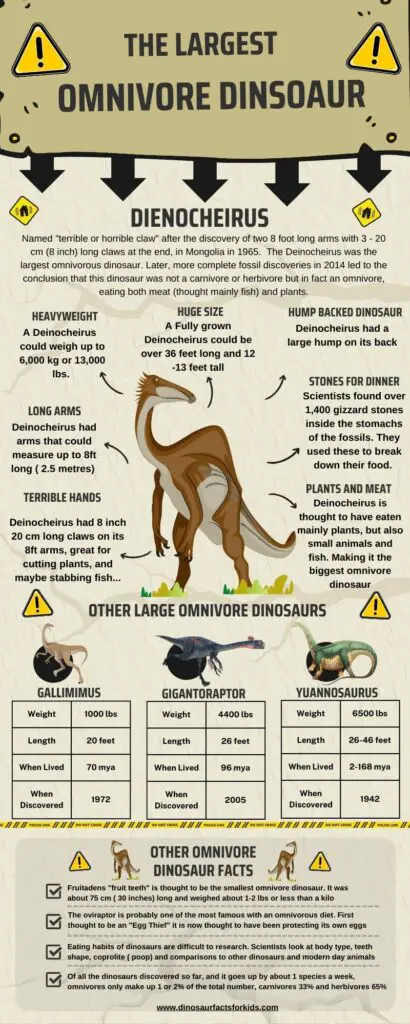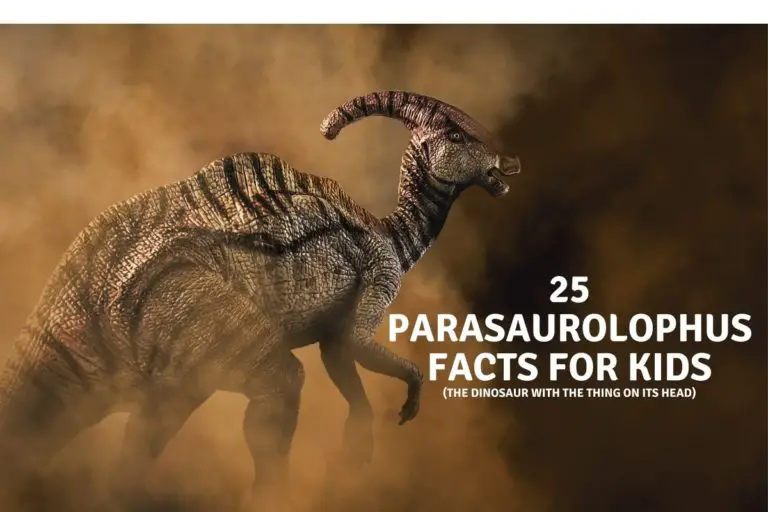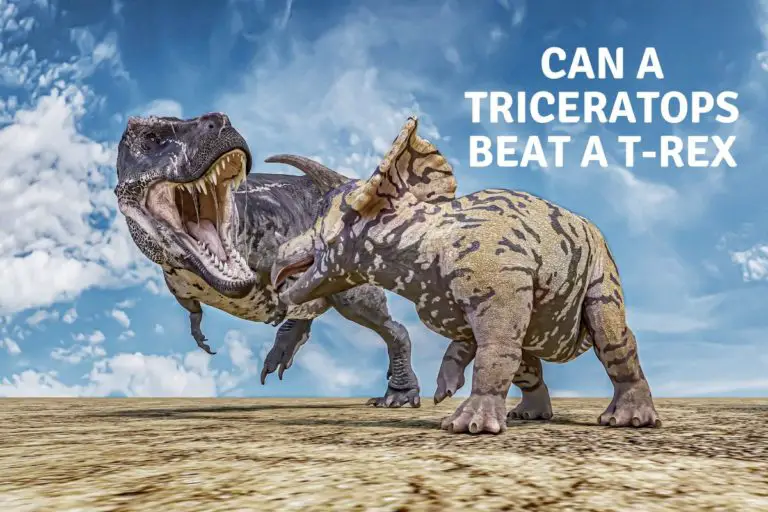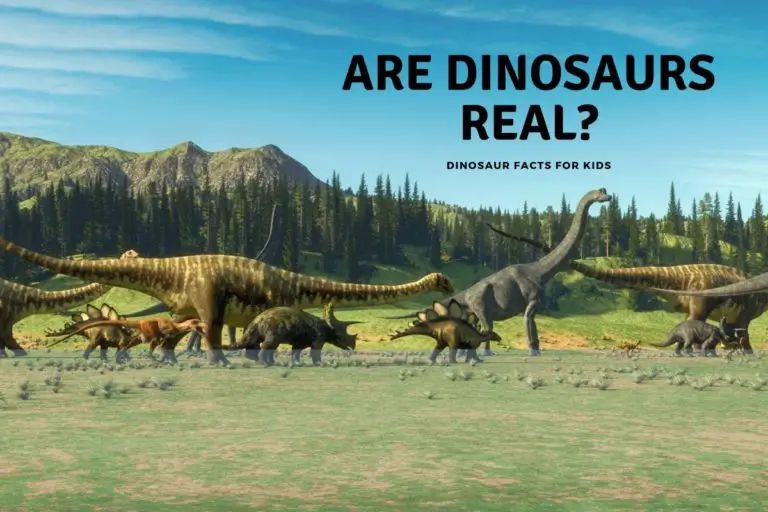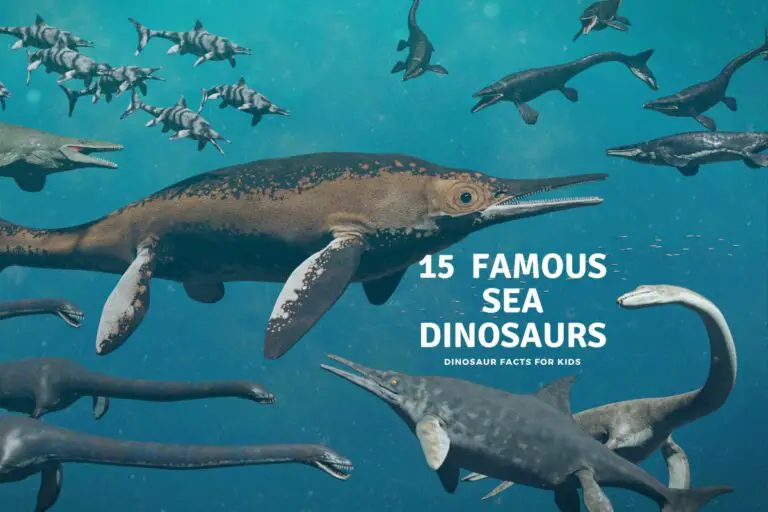What Did Omnivorous Dinosaurs Eat?
Even though dinosaurs are extinct, their unique and exciting lifestyle still intrigues many. People like to study types, diets, habits, and other certain traits of dinosaurs. While many have their favourites these tend to be the more famous large carnivores and herbivores, so for a change we decided to take a look at the Omnivorous dinosaurs, and answer the question what did they eat!
Omnivorous dinosaurs ate both plants and animals. Their diets could include plants, seeds, insects, lizards, mammals, eggs and smaller dinosaurs. They are recognized by possessing both canine and molar teeth, being, mostly bipedal and the remains of evidence of both plant and animal material in their coprolite (poop)
While herbivores and carnivores became specialized to their diet, and were very successful growing to huge sizes, the omnivorous dinosaurs appeared to be more generalized and with a few exceptions did not grow to the sizes of the largest meat and plant eating dinosaurs. We will take a look at omnivorous dinosaurs’ diets and how scientists gathered this information about their life in the article below.
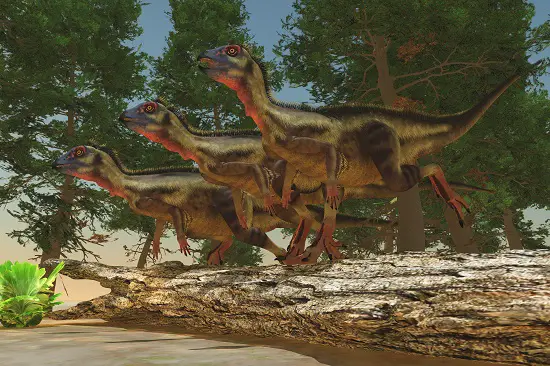
Omnivorous Dinosaurs Diet
Paleontologists research the knowledge we no know about dinosaurs through their fossils. They discovered that each dinosaur was unique and possessed different characteristics from the others, although size is the most obvious there were also habitats, abilities and as we look at here, diets that were all very different. As far as dinosaurs’ diet and eating habits are concerned, most of them were herbivores, some were carnivores, and a few were omnivores. We take a look at the actual percentage below.
Omnivore dinosaurs were tough because they could survive in all kinds of conditions and habitats, as an example plenty of omnivorous dinosaur fossils have been found in what is now the Gobi desert, certainly not the the most hospitable of environments. They could eat plants and animals, which was a massive advantage for their longer life span. Since omnivores had an adaptable nature, they lived throughout the world.
These dinosaurs could adapt to their environment and alter their diet accordingly. During the shortage of plants, they survived on animals and vice versa. Omnivores hunted animals although would have likely only tried with animals much smaller than they were like lizards and mammals, and of course the occasional egg!
Here is the list of the diet of omnivorous dinosaurs:
- Plants
- Animals
- Insects
- Dinosaur eggs
- Reptiles
- Mammals
- Small dinosaurs
What Percentage of Dinosaurs were Herbivore, Carnivore or Omnivore
In all environments it is generally accepted that there will be a greater percentage of herbivore animals to carnivores. If there are two many carnivores they will eat there way through the plant eating animals and both will end up extinct so the numbers tend to balance themselves out.
in the time of dinosaurs the current estimate of the ratio to carnivore to herbivore is 65% herbivore to carnivore. that means for approximately every 3 herbivores there was a carnivore. Omnivorous dinosaurs are included within this carnivore percentage and make up 1-2% of the total.
You can see more in the table below and you can use and share the infographic on what makes an omnivore dinosaur if needed as well.
We suggest you read the notes below the table as well as the contents for percentage of carnivore to herbivore are somewhat surprising!
| Dinosaurs Vs Modern Animals | Carnivore | Herbivore | Omnivore |
| Dinosaurs | 33-34% | 65% | 1-2% |
| Modern Animals | 63% | 32% | 3% |
As you can see there are many more species of modern animal that are carnivorous than there were dinosaurs, However the figures are open to interpretation. it has been studied by John Wiens, an evolutionary biologist who works at the University of Arizona in Tucson, he studied over 1000 species alive today and their diets to come to the conclusion that currently about 63% are carnivores today with only 32 % of species being herbivorous.
This is on contrast to the current knowledge that 240 to 66 million years ago its was almost reversed. with 33% of dinosaurs being carnivores and 65 being herbivores. The similarity in figures is that omnivorous dinosaurs and modern animals only make up about 1-3% across both the time of the dinosaurs and the modern world.
Reasons given have been that plants although more available require specialised evolutionary traits to digest. The example is given of cows, which have 4 stomachs to help them digest plants.
However in the time of dinosaurs plants were less nutritious, less easy to break down and although some dinosaurs, like ankylosaurus for example, has evolved some specialization beyond just teeth ( they could ferment plants in their stomachs) they still outnumbered carnivore species. The difference is certainly something that needs further research.
With respect to omnivorous dinosaurs we have an infographic below to use and share that highlights how an omnivorous dinosaur might be classified.
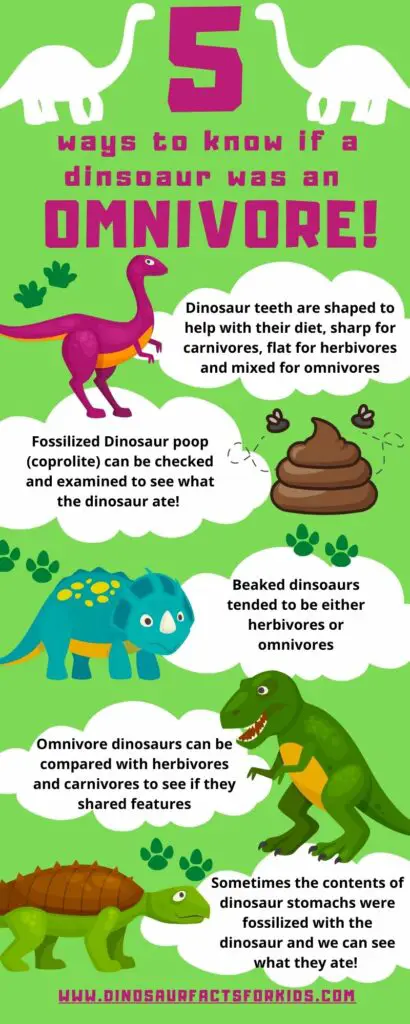
What is The Difference Between Carnivore, Herbivore and Omnivore Dinosaurs
| Dinosaur Diets | Definition | Examples |
| Carnivore | An animal that feeds on the meat of other animals | T-Rex, Spinosaurus, Velociraptor |
| Herbivore | An animal that feeds on plant and plant life | Triceratops, Stegosaurus, Brachiosaurus |
| Omnivore | An animal that eats both the meat of other animals and plants | Gallimimus, Oviraptor, Gigantoraptor |
Factors Deciding Dinosaur Diets
Dinosaurs are long gone, but new information and research is continually being found and undertaken. This is how scientists found out about the diets of different dinosaurs
We are going to discuss the factors that led to the discovery of dinosaur diets and how we can classify them as carnivorous, herbivorous or omnivorous:
- Teeth shape: The teeth of dinosaurs were a major deciding factor in their diet. They had different shapes and types of teeth according to their diets. For example, carnivores had sharp and long canines, so their fleshy diet became evident once paleontologists found their canine teeth, herbivores need to break up touch plant fibres and their teeth are flatter more useful for grinding, Omnivorous dinosaurs were a kind of half way house and had a mix of both molar and canine teeth.
- Dinosaur poop (coprolite): The waste material of omnivore dinosaurs indicated their eating habits. After testing and examining this fossilized dinosaur poop, scientists could see what the dinosaur had eaten. For example with bones, or seeds showing what the dinosaur had eaten.
- Gizzard Stones: In some cases, researchers found gizzard stones with the fossils, which were extremely helpful in providing details about their diet. They are often used by herbivores and omnivores to help break down tough plant material
- Stomach Size and Contents: The size of a dinosaur’s stomach tells a lot about its eating habits. Huge plant-eating dinosaurs needed bigger gut sizes to sustain all the food. Moreover, the stomach contents found with dinosaur fossils also told a thing or two about the dinosaur diet. for example Sinosauropteryx, had the bones of a mammal in its fossilized remains.
- Shared features: There are some body features that are shared between dinosaurs that help classify them and have an idea of their diet. For example all four legged dinosaurs are thought to have been herbivores. While this doesn’t mean all two legged dinosaurs were carnivores, it helps scientists to start yo look at similarities between other similar dinosaurs and use what they know to work out diets and habits of other dinosaurs.
Types of Omnivore Dinosaurs
Omnivore dinosaurs are divided into three groups: Troodontids, Oviraptorosaurs, and Ornithomimosaurs. These three groups have different omnivore dinosaurs under their name. Let’s find out some interesting facts about these groups of everything-eater dinosaurs:
| Groups | Interesting Facts |
| Oviraptorosaurs | Quite bigger than other omnivores; growing up to 8 meters in length and up to 2 tons in weight. Feathered body Parrot-like strong beaks |
| Ornithomimosaurs | Beak for breaking into eggs Toothless beak with weak jaws, meaning by they could not hunt other small dinosaurs Rigid stomach with the capability of digesting even rocks! |
| Troodontids | Smallest body but bigger brain Intelligent species Ate all kinds of fruits, seeds, eggs, small animals, and even insects |
Examples of Omnivore Dinosaurs
As you can see from above Omnivorous dinosaurs, and other animals, are somewhat of a rarity . they made up only 1 to 2 percent of dinosaurs and only 1 to 3 percent of modern animals.
We have a list of some well and lesser known omnivorous dinosaurs below.
- Gallimimus
- Hagryphus
- Khaan
- Oviraptor
- Shuvuuia
- Struthiomimus
- Gigantoraptor
There are more on this page from the Natural History Museum
Were Omnivore Dinosaurs Better Suited for Survival.
Dinosaurs were present in the world during the Mesozoic era when the conditions were quite harsh to live. It could have been extremely difficult for a carnivorous or herbivorous dinosaur to find food in deserts or hilly areas.
Fortunately, omnivorous dinosaurs could eat anything, Although they were not as specialized and herbivore or carnivore dinosaurs, they had more opportunities due to a large range of food they can eat. They also would have been able to feed from the remains of dinosaurs that had died from either another carnivore or natural causes.
They were also, mostly, smaller and would require less food it tough times. There are exceptions to that with dinosaurs like the gigantoraptor and the Melanorosaurus which was a proto Sauropod (an early Sauropod) . Sauropods are of course much better known to be the largest herbivores ever.
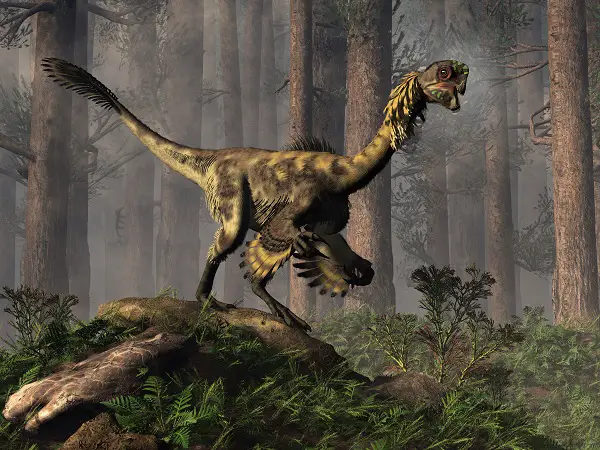
Characteristics of Omnivorous Dinosaurs
Each type of dinosaur had distinguishing characteristics and traits. So, let’s look at a few distinct characteristics of omnivore dinosaurs.
Teeth
Interestingly, most omnivores had both sharp and flat teeth. Their sharp teeth helped them to cut, shred and eat meat, while flat and blunt teeth for grinding and chewing plants. Some omnivorous dinosaurs had no teeth at all. Instead, they used their pointy sharp beaks to tear food and strong jaws to chew.
Digestive System
The digestive system of the omnivore dinosaurs was quite strong, and they could digest all kinds of plants and meat, although later an advantage, at the time more specialized dinosaurs with specialized diets where hugely more common.
Size
Most omnivorous dinosaurs were small, and their smaller size allowed them to roam freely and prey for food easily as we mention above size, as well as speed, can be advantages if there are long periods of drought or less food.
Nomadic Behavior
The paleontologists noticed fossils of omnivore dinosaurs spread throughout the world. Since omnivores could survive in harsher conditions, they lived worldwide without worrying about food. They were skillful enough to find their food everywhere; hence it was easier for them to migrate. Frequent migraters, or in other words, we might call them fond of traveling, omnivorous dinosaurs just kept changing their habitat in search of food.
We have another infographic on the largest Omnivore dinosaurs here as well as an article on the largest omnivore dinosaurs on the site as well. You can click the picture to make it full size.
Frequently Asked Questions
How to Determine Whether a Dinosaur Was Omnivore or Another?
Paleontologists determined the type of dinosaurs by examining their teeth. For chewing and shredding vegetables, they had flat teeth like herbivorous dinosaurs. Moreover, they also studied feces, stomach size, and gizzard stones to gather more information about dinosaurs’ diets.
Did Dinosaurs Drink Water?
Yes, as per some studies, dinosaurs drank fresh water. They were fond of water and would regularly drink water to stay hydrated. Carnivores and omnivores used to hunt their prey near water like modern day predators.
How Many Dinosaurs Were Omnivores?
Only 1-2% of dinosaurs were omnivores, which is quite less than herbivores and carnivores. They were a special type of dinosaur that survived on various types of food; hence they were less in number.
Conclusion
In the article above we discussed the eating habits of omnivorous dinosaurs and explained what they were. We looked at what makes a dinosaur an Omnivore and the differences between the three dietary types of dinosaurs.
Omnivore dinosaurs ate both plants and meat, although there were less species of omnivorous dinosaurs than herbivores and carnivores they were widespread and their size and more adaptable diets would be of benefit when there were periods of food shortages.
References
- https://www.nhm.ac.uk/discover/dino-directory/diet/omnivores/gallery.html
- https://adventuredinosaurs.com/2020/09/08/what-did-omnivorous-dinosaurs-eat-facts-omnivores/
- https://blog.everythingdinosaur.com/blog/_archives/2008/05/14/the-proportion-of-plant-eating-dinosaurs-to-meat-eating-dinosaurs.html
- https://www.science.org/content/article/world-s-first-animal-was-probably-carnivore
Hi, I am Roy Ford a General Studies and English Teacher who has taught all over the world. What started as a fossil collection became a great way to teach, motivate and inspire students of all ages and all over the world about dinosaurs and from that and children’s love of dinosaurs came the site dinosaur facts for kids, a resource for all ages.

